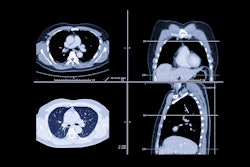CHICAGO - Women who undergo screening CT run the risk of receiving a radiation dose to the breast that may be 19 times greater than a standard mammogram, according to researchers from the University of Cincinnati and Duke University in Durham, NC.
“Medical radiation is the largest source of radiation exposure to the population other than natural background radiation. CT scanning contributes a major portion of this medical radiation. It accounts for only 15% of diagnostic procedures, but contributing nearly 70% of the total radiation burden associated with medical imaging,” said Dr. Mary Catherine Mahoney during a talk at the RSNA meeting on Thursday. One of Mahoney’s co-authors is Dr. Rendon Nelson from Duke, who also serves a consultant to GE Medical Systems.
Although professional organizations and published reports have addressed the CT dose issue, multidetector CT radiation dose continues to climb as radiologists place a premium on achieving fast, high resolution images amenable to 3-D formats, Mahoney said.
For this phantom study done at both institutions, CT exams were performed on 4-slice multidetector scanners (LightSpeed QX/i, GE Medical Systems, Waukesha, WI. The two types of breast phantoms used were the Alderson Phantom with breast attachments and removable TLD plugs, and the CIRS phantom with MOSFET Auto-Sense Systems metal oxide detectors.
Standard protocols for the following CT exams were used: lung cancer, coronary calcium scoring, virtual colonoscopy, and total body. The kV for every exam was 120. The mA included 360 for coronary calcium screening and 280 for whole-body screening.
“The calculated radiation doses to the breasts from each of the CT screening studies were then compared with the mean glandular dose from standard (four-view) mammography,” Mahoney said.
According to the results, the average radiation doses per breast was 0.41 rads during lung cancer screening; 3.7 rads during coronary calcium scoring, 0.94 rads during virtual colonoscopy, and 1.8 rads during whole-body screening.
In comparison, the average dose for a four-view breast study was 0.2 rads per breast.
“Coronary calcium scoring and whole-body screening provided the greatest radiation doses to the breast,” she said. “Lung cancer screening and virtual colonoscopy were in the same range as mammography.”
Patients undergoing screening CT receive a radiation dose to each breast that ranges from two to 19 times that of a mammogram. The additional exposure should be considered when counseling patients about CT screening risks, Mahoney concluded.
Session moderation Dr. Gilda Cardenosa asked Mahoney how her group was applying this knowledge at their institutions.
“At (
By Shalmali
Pal
AuntMinnie.com staff writer
Copyright © 2003 AuntMinnie.com




















